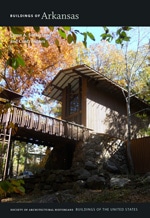Little is known about this fanciful Queen Anne house’s construction, and an architectural pattern book probably provided inspiration for its design. Perfectly suited to its corner site, the two-story frame building has two perpendicular gabled wings linked by a two-story angled verandah, which is surmounted by an octagonal cupola. The turned porch supports, grouped in triplets, along with curved brackets, lacy spindlework brackets, and balustrades, and the delicacy of the cupola create a surprising airiness for such a large structure. The most interesting interior feature is a circular stairway rising from the front hall. The major exterior alteration occurred in 1973 when the original one-story rear wing was replaced with a two-story addition. The Bailey House and its original outbuildings, including stables, chicken coops, a well house, and a smokehouse, and ornamental and vegetable gardens, once occupied an entire city block. James Monroe Bailey, a Georgia native who moved to Bradley County in 1860, was serving in the Confederate Fifth Arkansas Regiment when he was wounded and taken prisoner, ironically, in Georgia. In a change of postwar fortune, he returned to Warren and became a successful entrepreneur, operating a drugstore on the south side of the courthouse square that was within walking distance of his picturesque dwelling.
You are here
James Monroe Bailey House
If SAH Archipedia has been useful to you, please consider supporting it.
SAH Archipedia tells the story of the United States through its buildings, landscapes, and cities. This freely available resource empowers the public with authoritative knowledge that deepens their understanding and appreciation of the built environment. But the Society of Architectural Historians, which created SAH Archipedia with University of Virginia Press, needs your support to maintain the high-caliber research, writing, photography, cartography, editing, design, and programming that make SAH Archipedia a trusted online resource available to all who value the history of place, heritage tourism, and learning.






